Spinner Fishing For Salmon: Guide Tips And Tactics
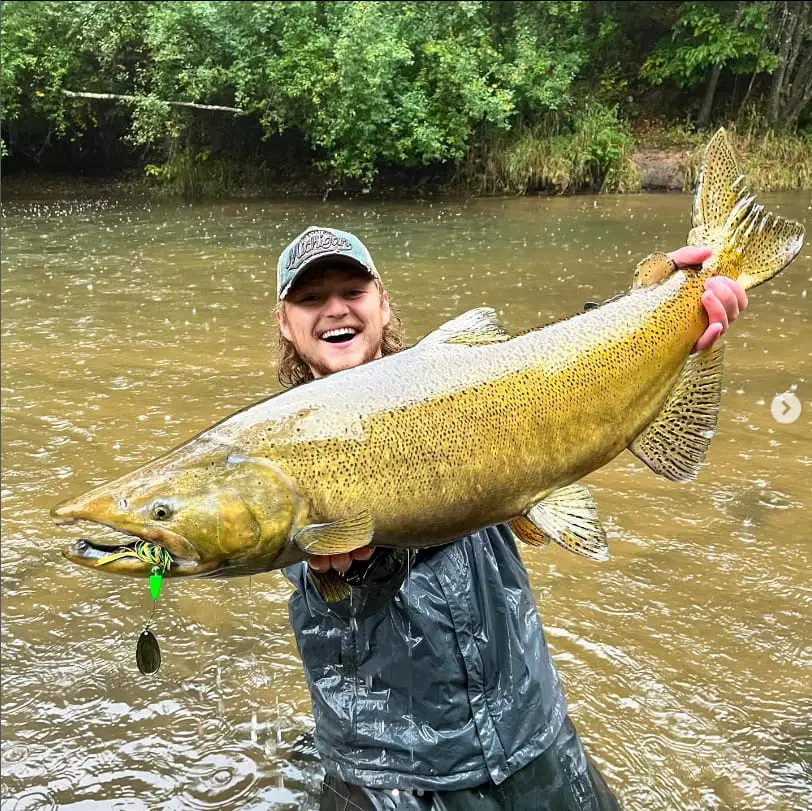
As a guide, I cater to the ways of fishing that my clients want to use to catch salmon. For this reason, I need to be well-versed in many different methods, including spinner fishing for salmon.
I have learned the methods, tips, and tricks other guides use to be more successful with spinners, and I use them myself when guiding clients. I will share these methods with you here.
Guides when they are fishing for salmon in rivers, off piers, and from near-shore shorelines.
- Spinners: I have found that certain spinners are more effective than others. This is because of factors such as the spinner’s vibration, flash, and how they run in currents. I will tell you my favorites and why.
- Size: I will choose certain sizes based on the conditions.
- Color: I choose specific colors based on the conditions. I will also rotate through different colors if the steelhead doesn’t bite one color.
- Cover The Water: I systematically cover the entire spot to catch the maximum amount of steelhead.
- Depth: I have ways to determine the optimal depth.
- Speed and Angles: I change retrieve speed and directions based on the conditions and fish activity.
- Lure Action: I have unique ways to trigger more bites when using spinners and other lures.
Other good fishing guides use these same methods, and if you aren’t, you are MISSING FISH!
Can Spinners Catch Salmon?
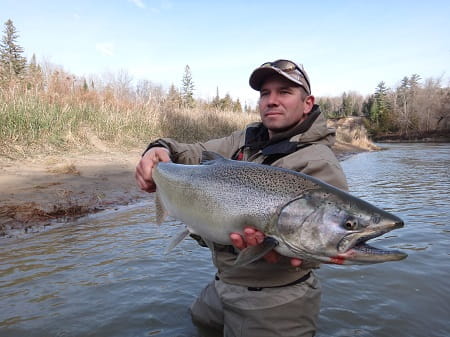
When it comes to attracting salmon during their spawning period, utilizing a well-executed spinner presentation can yield great results.
During their migration upriver for spawning, salmon exhibit aggressive behavior, causing them to strike at anything that appears threatening or intrudes upon their territory.
This is where spinners come into play. Spinners resemble baitfish and vibrate enticingly, which can effectively trigger a strike response from salmon that would not normally want to bite.
When used in rivers and near the shore or river mouths, spinners are highly effective in enticing all species of salmon. Mastering my three proven presentation methods, covering the entire water column effectively, and understanding the optimal spinner depth is important if you want the most success when salmon fishing with spinners.
It’s also important to use the same spinners that experienced anglers and salmon guides use. Factors such as size, color, and following the techniques employed by seasoned river guides also play significant roles in salmon fishing success.

When I guide for salmon using spinners, my approach varies based on multiple factors, including river conditions, depth, water clarity, current speed, and salmon activity level.
I firmly believe that selecting the most suitable spinner based on these conditions is critical.
Another advantage of using spinners is the ability to cover a large area of water quickly, including multiple depths.
Basics Of Spinner Fishing for Salmon
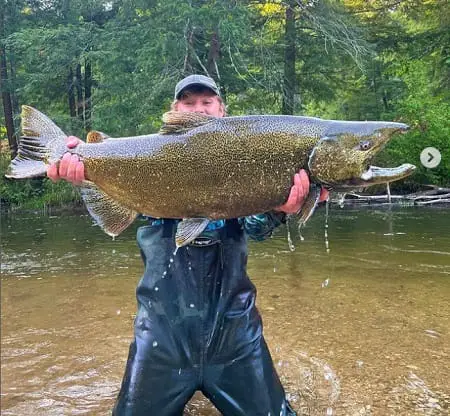
Basic spinner fishing is relatively straightforward and somewhat easy.
Even anglers without much experience in this technique still have a decent chance of hooking into a salmon or two. But learning more advanced methods will greatly improve your success.
The spinner consists of a spoon-shaped blade rotating around a shaft with a single hook or a treble hook attached at the back. The blades vibrate and move water, as well as have flash that attract the salmon.
The vibration can attract the salmon’s attention from a considerable distance, even exceeding 20 feet, while the flash triggers a strike when the spinner is within close proximity of the salmon.
However, not all spinners are suitable for salmon fishing, and certain spinners are proven to be more effective than others.
As a salmon guide, I know that choosing the right size spinner, the right color, and the right weight is crucial to my clients catching the most salmon possible.
It is also important that I use high-quality, durable spinners, with strong hooks that are capable of withstanding the fight with a large salmon. It’s not uncommon for salmon to bend or break the hooks of some brands of spinners.
Effective Spinners For Salmon Fishing
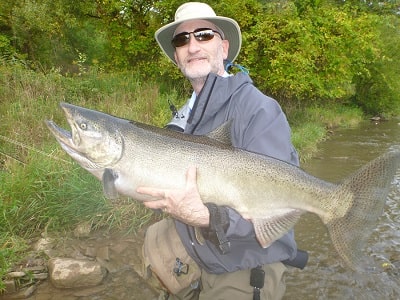
I think that selecting the appropriate spinner is key to achieving success in salmon fishing.
There are two main types of spinners for salmon:
- Long Blade Spinners: These spinners are specifically designed for faster and deeper retrieves. These long-blade or thin-blade spinners excel in slower currents and in deeper water.
- Wide Blade Spinners: Wide-blade spinners move at a slower pace, they displace more water, they remain higher in the water column, and they often create more vibration. They are suitable for shallower water and faster currents.
Among experienced guides, wide-blade spinners are the preferred choice for salmon fishing. Optimal spinner lengths for salmon range from 3 to 4 inches, which closely match the size of most baitfish found in rivers.
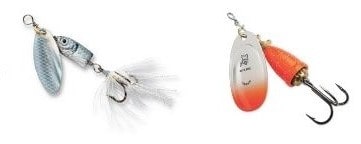
As a general guideline, I prefer larger spinners up to five inches in turbid or high-flow conditions and dirtier water. I prefer smaller spinners for clear water or when targeting cautious salmon that are holding in pools or pockets.
Now, let’s explore some of my favorite spinners for salmon fishing in rivers:
- Mepps Aglia: The Mepps Spinner line is widely recognized as one of the most popular spinners for salmon fishing. These spinners perform exceptionally well in rivers and are suitable for casting off piers or shorelines. The 4-inch size and #4, #5, and #6 blades are my go-to options for fishing in larger water bodies and targeting big salmon.
- Blue Fox Vibrax: The Blue Fox Vibrax spinners are personally my favorite and my most frequently used spinners for salmon fishing. Through extensive testing, I have found that the Vibrax design produces more vibration than any other spinner on the market, resulting in greater success. This Vibrax spinner is particularly effective in higher or dirtier water due to its increased vibration. The 3 to 4-inch length and blade sizes ranging from #3 to #6 are perfect for targeting larger salmon.
- Panther Martin Spinners: The 3-inch size of this spinner has proven to be popular and effective for salmon fishing. It performs excellently in rivers and is also suitable for pier fishing.
- Blue Fox Vibrax Bullet: This spinner is specifically designed for deeper water and faster retrieves. It has garnered high ratings and is known for its reliability when fishing for salmon.
- Mepps Flashabou Spinner: I am particularly fond of the tail action and flash exhibited by this spinner. In certain scenarios, when other spinners fail to produce desired results, especially when targeting larger salmon, the Mepps Flashabou Spinner has proven to be more effective in rivers.
Check out even more of my favorite spinners for salmon as well as some of my most effective salmon lures.
Selecting the Best Spinner Colors for Salmon
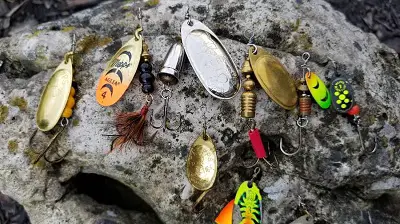
The color of the spinner can significantly impact the likelihood of enticing salmon to bite, taking into account the salmon’s mood, water clarity, and lighting conditions.
Silver, gold, or brightly colored spinners with reflective surfaces tend to be the most effective as they create a flash that can be seen from a distance.
Under specific conditions, I have experienced great success with black spinners or black/silver combinations. Bright days can be great for black spinners. Examples of black-colored spinners include Mepps Black Furrys and Panther Martins.
Based on my experience, the most consistent spinner colors for salmon fishing in rivers are chartreuse, chartreuse/silver, silver, silver/orange, green/silver, and blue/silver. These colors have repeatedly proven successful in attracting salmon.
By employing the right techniques, selecting suitable spinners, and paying attention to factors such as size, color, and water conditions, you can significantly increase your chances of a successful salmon fishing trip.
Three Proven Techniques for Spinner Fishing
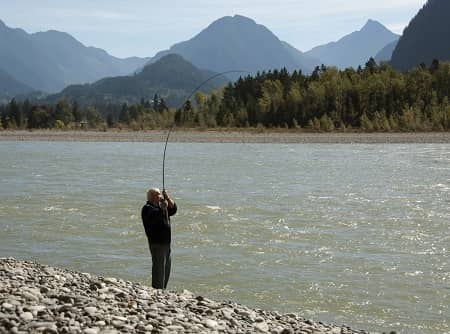
There are three reliable techniques for spinner fishing when targeting salmon:
Method #1: The widely used approach involves casting the spinner into the river and retrieving it steadily with a smooth motion.
Depending on the river’s depth and speed, you may need to allow the spinner to sink briefly or adjust its depth accordingly.
To enhance this method’s effectiveness, incorporating occasional gentle pulls or twitches can simulate the behavior of an injured or dying baitfish. This irregular retrieval often leads to more successful salmon catches.
Method #2: This technique is ideal for faster currents. Cast the spinner across the river and slightly downstream, allowing the natural current to carry the lure across the pool without reeling. This “swinging” technique creates a downstream and lateral movement of the spinner, captivating salmon and enticing them to strike.
Method #3: In this method, cast the spinner diagonally across the river, allowing it to sink to the riverbed. Raise the rod tip from waist height to a few feet above your head, then lower it and repeat the motion.
Elevating the rod tip swiftly facilitates the rotation of the blades.
This action imitates the erratic movements of an injured baitfish. The spinner’s descending flutter can trigger an aggressive response from salmon.
This jigging method proves particularly effective in salmon-congregated areas, such as beneath waterfalls or behind large river obstacles, as well as in pockets of calm water.
Determining The Retrieval Speed For Spinners:
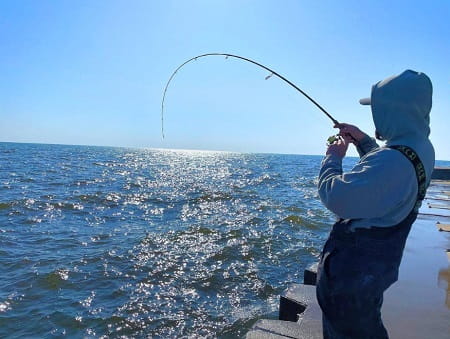
The rate at which you reel in the spinner depends on various factors, such as its action, your reel speed, and the speed of the current.
It’s crucial for the spinner’s blade to spin properly, and this is usually achieved at a specific speed.
Reeling too slowly won’t generate enough vibrations, while reeling too quickly may hinder the blades’ effective rotation.
I suggest maintaining an appropriate retrieval speed that allows the salmon to detect the spinner through sound and sight, encouraging them to strike. This speed typically falls within the slow to medium range.
However, there are instances where you can retrieve the spinner at a faster pace to cover more water, especially when targeting more aggressive salmon that are inclined to chase a swiftly moving lure.
If you notice the spinner repeatedly popping out of the water’s surface, it indicates that you are reeling too fast or holding your rod tip too high. To ensure an optimal presentation, strive for a consistent speed. If the current is faster in the middle of the river, adjust your reeling speed to match the pace of the current.
In extremely swift currents, you may not need to reel at all, allowing the lure to swing naturally across the river.
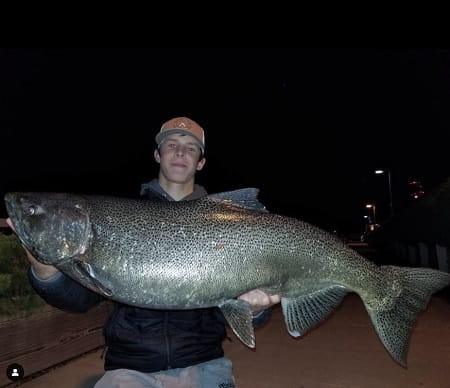
Keep in mind that the faster you reel the spinner, the higher it will stay in the water column. However, this might not be advantageous when targeting salmon that prefer to hold deep and are hesitant to rise for a lure.
Night fishing for salmon can be very effective, and at night, you will need the slowest retrieve speed possible. I discuss night fishing more below.
Determining the Best Depth for Spinner Fishing:
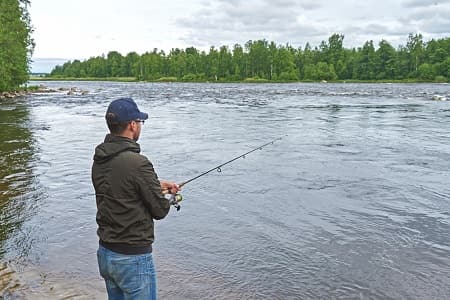
Finding the optimal depth for spinner fishing is essential when targeting salmon. While salmon typically stay close to the riverbed, it doesn’t mean that your spinner should be at the same depth.
To ensure success, it’s crucial to position your spinner a few feet above the salmon’s heads. A general rule is to aim for 2 to 3 feet above the salmon, but in clear water, you can position it 5 to 6 feet higher.
Keeping the spinner within the salmon’s striking zone is key.
Remember to avoid dragging it along the riverbed, as this can reduce its effectiveness and lead to more snags. Getting your spinner close to the salmon increases the chances of getting them to strike, but determining the precise depth requires strategic techniques.
Fishing At Different Depths
When using spinners, there are two primary approaches for positioning the lure in the water column. In most cases, salmon can be found near the bottom, but there are instances when they may be suspended at higher levels. Let’s explore both methods:
Fishing High for Salmon
In shallower rivers or areas less than 6 feet deep, you can start reeling as soon as the spinner touches the water.
This keeps the spinner elevated in the water column and keeps it over the salmon heads. Sometimes, the spinner may be only a foot or two below the surface, which is sufficient if the water is 5 feet deep or less.
To keep the spinner within the salmon’s striking zone, you may need to hold your rod tip high and prevent it from touching the bottom. Adjusting the elevation of your rod tip depends on factors such as current speed, spinner weight, and water depth.
If the spinner keeps hitting the bottom with a waist-high rod tip, raise the rod tip to about head height for a higher presentation. If the spinner continues to hit the bottom you should lift the rod tip even higher, although I rarely find it necessary to lift it above my head.
Fishing Deep For Salmon
To reach greater depths, cast your spinner straight across the river or slightly upstream and allow the spinner to sink before starting the retrieval. The longer you wait before retrieving, the deeper the spinner will sink.
While reeling in, the spinner may start to rise, but maintaining a slower retrieval speed helps to keep it at the desired depth.
Keeping the rod tip low also prevents the spinner from rising too quickly.
In some cases, submerging the rod tip below the water’s surface maximizes the depth and prevents the spinner from rising.
If you consistently notice the spinner hitting the bottom, it indicates that you are fishing too deep.
A helpful tip is to let the spinner sink completely. Once you believe it has reached the bottom, lift the rod tip abruptly by about 3 feet, which gets the blades spinning, and then start reeling at a slow to medium speed with the rod tip at waist height.
This technique usually positions the spinner about 3 to 4 feet off the bottom, which is typically an ideal depth.
Covering All Depths of the Water Column
I use a systematic approach to determine the appropriate depth I should be fishing.
Unfortunately, many anglers cast and reel without knowing the spinner’s depth or the fish’s position, resulting in guesswork and I’m sure plenty of missed fish. To optimize your chances of success, follow my tactics:
First Cast: Begin by covering the top part of the water column with your first cast. Start reeling immediately and maintain a slow pace to keep the spinner near the surface.
Second Cast: Repeat the cast, aiming to land the spinner in the exact same spot as the previous cast. This time, allow the spinner to sink 3 to 6 feet or for 3 to 6 seconds. Lower your rod tip to the water’s surface or slightly below it to target the middle or lower part of the water column effectively.
Third Cast: If you haven’t received any bites or hit the bottom on the first two casts, cast back to the exact same spot and let the spinner sink even deeper, or potentially all the way to the bottom, before starting the retrieval.
Once the spinner reaches the bottom, lift the rod tip 3 to 6 feet to suspend the spinner at about of 3 to 6 feet above the riverbed and slowly retrieve the spinner in.
Repeat: Once you are confident that you are close to the river bottom, cast 3 to 5 feet downstream from your previous cast and repeat the process. Pay close attention to any bites or bumps you receive during any of the three casts. These indicators can help you determine the depth at which the fish are actively feeding or holding.
Once you have identified the successful depth, whether on the first, second, or third cast, focus on that depth for subsequent casts. By doing so, you can eliminate the need for the initial casts and cover the fishing area more efficiently and quickly.
This methodical approach of discovering the fish’s location proves more effective than simply casting over a large area and hoping that the spinner is in the right place.
Casting Direction for Spinner Fishing
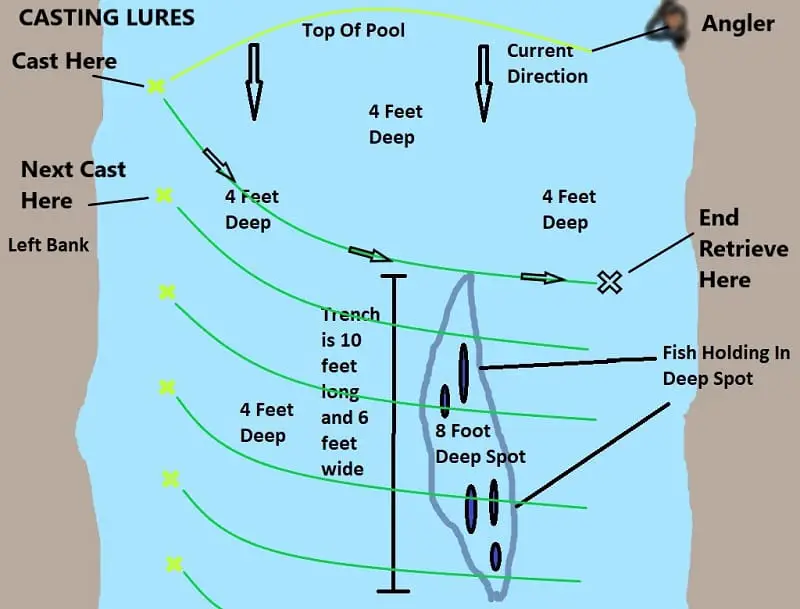
In my experience, casting straight across the river or slightly downstream yields better results then casting up river or straight downriver.
While some anglers prefer casting upstream and retrieving the spinner downstream, I have found that casting straight across is more effective.
Casting a spinner upstream may cause it to sink deeper, but presenting the spinner head-on to the fish can startle them or make it more difficult for them to strike. Additionally, the downward current counteracts the necessary blade rotation, preventing the blades from spinning properly.
On the other hand, casting a spinner across the fish’s field of view, allowing it to swing sideways, presents a more enticing, more natural, and an easier target.
This is why casting the spinner across the river and using a sideways retrieve is my preferred and most effective method.
Efficiently Covering the Water
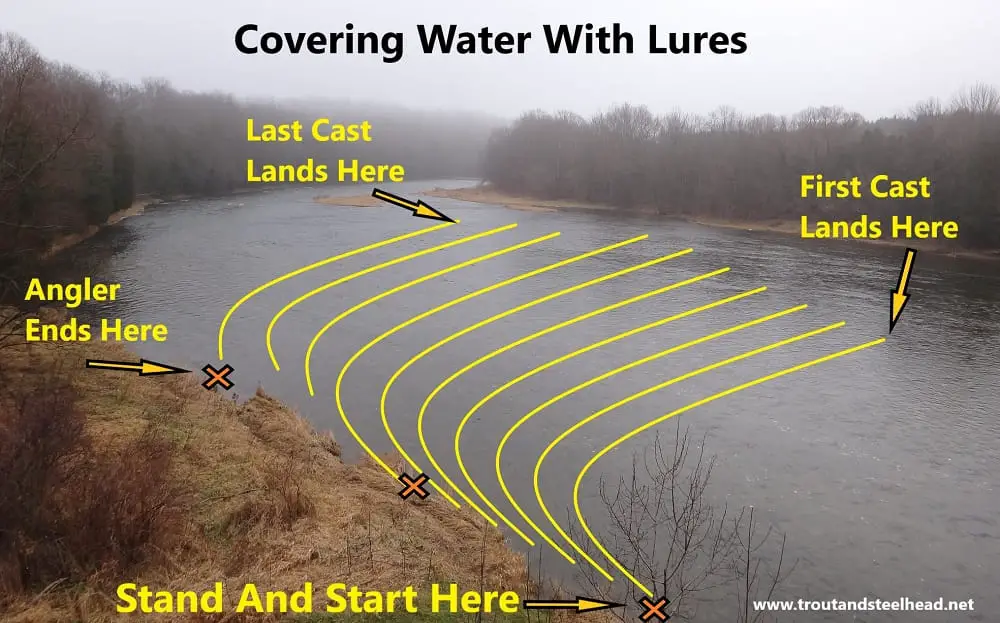
To maximize your chances of success when using spinners for salmon fishing, it’s essential to cover the water systematically.
Instead of casting randomly in all directions, adopt a methodical approach that covers the water from top to bottom.
Start your first retrieve at the top of the fishing spot and gradually move the retrieval down by 3 to 5 feet with each subsequent cast. This approach ensures that every fish in the area has an opportunity to see and strike at the spinner, leaving no gaps in coverage.
Implementing this systematic coverage technique is what sets guides and me apart from anglers who cast aimlessly and miss potential opportunities.
By being deliberate and thorough in your coverage, you increase your chances of enticing strikes and landing more salmon.
Understanding River Conditions for Spinner Selection and Fishing Tactics
A comprehensive understanding of river conditions is vital for adapting your spinner fishing tactics. Factors such as water depth, current speed, water clarity, the presence of structures like rocks and logs, and the width of the river all influence salmon behavior and should guide your approach.
Remaining flexible and adjusting your strategies based on the specific river conditions is crucial. Let’s consider a few scenarios:
Clear Water Spinner Fishing
When salmon fishing with spinners in clear water conditions, you have the advantage of running your spinner up to 6 feet away from a salmon and still potentially attracting bites.
Silver and brightly colored spinners with reflective surfaces work well in these conditions as they create a visible flash. A slightly faster retrieval speed can be effective since the salmon can spot the lure from a greater distance and have more time to react.
However, in shallow clear, water, salmon can be easily startled by the splash of the spinner or its proximity. To overcome this, consider using smaller and less flashy spinners. Cast them farther away from the fish and retrieve them at a slower pace to avoid spooking them.
Avoid landing the spinner directly on top of the fish or in the middle of the pool. Instead, aim to cast it as close to the far bank as possible and pull the spinner in front of and past the fish.
Also, retrieving a spinner behind the salmon can also startle them and trigger a strike.
Dirty or Stained Water Spinner Fishing
When salmon fishing with spinners in dirtier or stained water with reduced visibility, it becomes crucial to bring the spinner closer to the salmon, ideally within a foot or two. Slow down your retrieval speed to accommodate the limited visibility.
The jigging retrieve method is particularly effective in these conditions, as it allows the salmon to locate and strike at the spinner even when visibility is poor. In very muddy water, I recommend using the noisiest spinner available or even opting for a crankbait with a rattle. The additional noise helps salmon locate and strike at the lure when they can’t rely solely on their sight.
In such conditions, larger spinners and bright chartreuse colors tend to provide better visibility. Adjusting your tactics to suit the water conditions increases your chances of success.
Fast and Slow Water Spinner Fishing
When salmon fishing with spinners in faster currents, employing the swing method is beneficial. Cast the spinner across the river and allow the current to carry it downstream, imitating the movement of a baitfish. Avoid reeling too quickly, as it can cause the spinner to spin out or become too fast for the fish to detect and strike.
Conversely, in slower water, a slow to medium-speed retrieval or a jigging retrieve tends to work best. The swing method is less effective in these conditions since the slow current doesn’t provide enough speed to spin the blades of the spinner and may cause it to hit and drag along the riverbed.
By adjusting your retrieval speed and choosing the appropriate technique for the water speed, you can effectively present the spinner to the fish and increase your chances of enticing strikes.
Spinners At Night
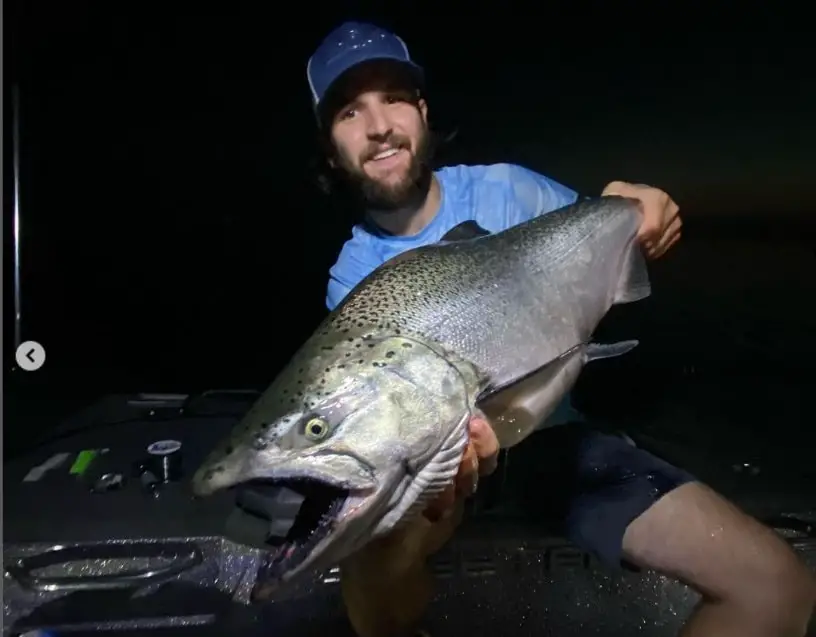
Salmon often enter the rivers at dusk and through the night because they prefer the darkness when traveling through the shallow rivers. Salmon will also feed at night on baits and on lures.
Spinners are my go-to lure at night because they move straight, they can move fairly slow, and mostly because of the vibration which gets the salmon’s attention, and because they can home in on the vibrations and hit the lure easier in the dark than other lures.
My go-to retrieve is the swing retrieve due to the current spinning the blades quickly, which causes more vibration but still allows the lure to slowly swing across the river.
Casting spinners off the pier and shoreline near the mouth of the river can be very effective.
Learning the many different methods of salmon fishing will improve your success since it’s common that some methods won’t work, while other methods can be very effective.
Tight Lines
Graham
